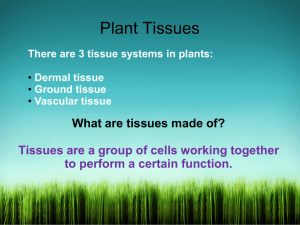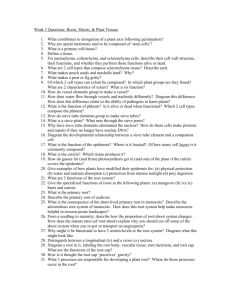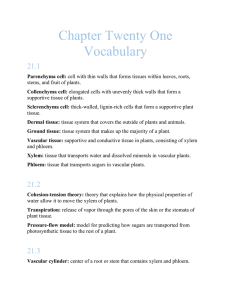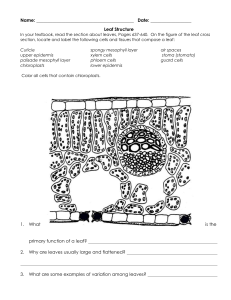Simple tissues of parenchyma, collenchyma and sclerenchyma
advertisement
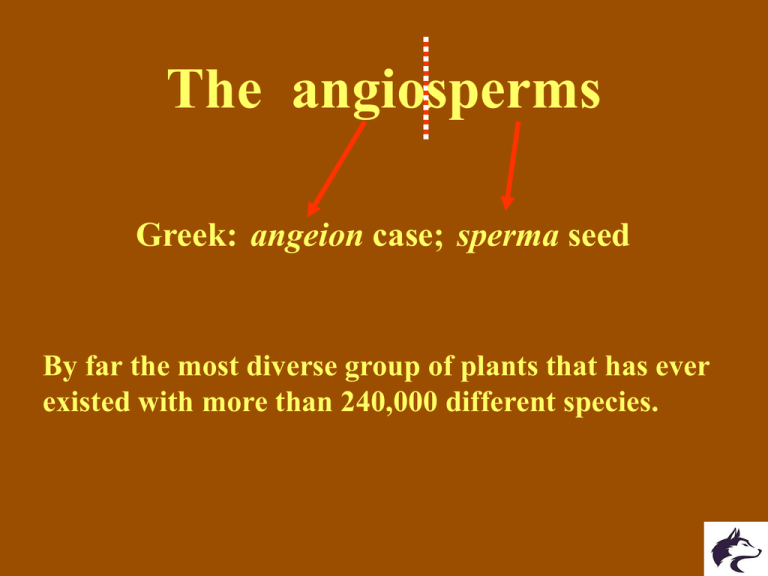
The angiosperms Greek: angeion case; sperma seed By far the most diverse group of plants that has ever existed with more than 240,000 different species. Time of origin of plant groups Angiosperms Conifers Ferns Mosses Why are there do many species? Why are there so many species? West Gondwana, equivalent to modern South America plus Africa Gondwanaland Two things before discussing the Angiosperms: [A] Simple tissues of parenchyma, collenchyma and sclerenchyma [B] There are two classes of flowering plants, Monocotyledons and Dicotyledons [A] Simple tissues of parenchyma, collenchyma and sclerenchyma Important structural tissues of many angiosperms epidermis collenchyma sclerenchyma xylem pholem parenchyma Transverse section Fig. 29.5, p. 502 Examples PARENCHYMA COLLENCHYMA SCLERENCHYMA Fig. 29.6, p. 502 [B] There are two classes of flowering plants, Monocotyledons and Dicotyledons In seeds, two cotyledons (part of the embryo) DICOTS Usually four or five floral parts (or multiples of these) Usually a netlike array of leaf veins Basically, three pores of furrows in pollen grain vascular bundle Vascular bundles arrayed as a ring in stem In seeds only one cotyledon Dicotyledon – Monocotyledon Usually three floral parts (or differences multiples of three) MONOCOTS Usually a parallel array of leaf veins Basically, one pore or furrow in pollen grain Vascular bundles distributed ground 29.10, p. 503 tissue ofFig. stem Principal differences between Angiosperms and Gymnosperms 1. Angiosperm leaves have finely divided venation; typically gymnosperm foliage e.g., conifer needles, have a single vascular strand 2. Angiosperm xylem contains vessels as well as tracheids and parenchyma 3. Angiosperm phloem contains sieve elements with companion cells rather than albuminous cells 4. Angiosperm ovules are protected within an enclosed structure rather sitting on a modified leaf 5. Double fertilization in the angiosperms produces a diploid zygote and triploid endosperm nucleus 6. In the angiosperms there are generally hermaphrodite flowers and cross pollinating (70%). Wind pollination is typical in the gymnosperms animal pollination widespread in angiosperms 1. Leaves have finely divided venation A dicotyledon Coleus leaf cleared of cell contents and with xylem stained So? Why is that important? Typically veins are distributed such that mesophyll cells are close to a vein. The network of veins also provides a supportive framework for the leaf. Leaf of a monocotyledon plant The major venation follows the long axis of the leaf and there are numerous joining cross veins so that, as with the dicotyledon, mesophyll cells are always close to a vein. leaf vein (one vascular bundle inside the leaf) xylem cuticle of upper epidermis phloem Water and dissolved mineral ionsDiagram of a dicot leaf move from roots into stems, then into leaf vein (blue arrow) UPPER EPIDERMIS My textbook has xylem and phloem wrongly labeled PALISADE MESOPHYLL SPONGY MESOPHYLL LOWER EPIDERMIS Products of Photosynthesis (pink arrow) enter vein and are transported to stems, roots) Oxygen and water vapor escape from the leaf through stomata cuticle-coated cell of lower epidermis Carbon dioxide from the surrounding air enters the leaf through stomata one stoma (opening across the epidermis) Fig. 29.16, p. 507 Tomato leaf Upper epidermis Palisade parenchyma: chloroplasts visible around cell periphery Longitudinal section through a vascular bundle Xylem vessel: annular thickening around cell wall Phloem Bundle Sheath Spongy parenchyma Lower epidermis … C3 and C4 photosynthesis? Photorespiration and biochemical strategies to avoid it C3 C4 RuBisCO PEP carboxylase Dicots Monocots CAM 6CO2 + 6H2O C6H12O6 + 6O2 (18ATP, 12 NADPH) C3 6CO2 + 6H2O C6H12O6 + 6O2 (30ATP, 12 NADPH) C4 Leaf cross section of Zea mays ("corn"). Bulliform cells Upper epidermis Xylem Bundle sheath cells with chloroplasts Parenchyma with chloroplasts Phloem http://www.uri.edu/artsci/bio/plant_anatomy/99.html Lower epidermis Anatomical separation of the C4 photosynthesis component processes Parenchyma filled with chloroplasts Bundle sheath cells filled with chloroplasts. CALVIN REACTION SITE Xylem Phloem Carbon skeleton compounds return to parenchyma C4 acids synthesized in the parenchyma move to the bundle sheath Maize 3394 2. Xylem contains vessels as well as tracheids and parenchyma Tracheids provide better support but less slower rates of water conduction than vessels Vessel A vessel is composed of several vessel elements Tracheid Tracheids lack perforation plates but their end walls contain numerous pits. Wide vessel element: This kind of cell is better for fluid conduction than physical support. These vessel elements have completely perforated end walls Elongated vessel element: This cell provides moderate support but superior fluid conduction compared to a tracheid 3. Phloem contains sieve elements with companion cells Sieve Tube Members (STM) Companion Cells (CC) Cucurbita phloem (cucumber) Sieve plate STMs and CCs develop from the same progenitor cell. STMs unite vertically to form a Sieve Tube. STMs have no nucleus at maturity and depend on CC to regulate physiological processes. Angelica stem J. D. Mauseth Four zones: transverse section Typical of a dicotyledon without secondary thickening. 1) epidermis Dicotyledon stem cross section 2) cortex, in many species the outermost part is a hypodermis We eat Angelica in confectionary 3) ring of vascular bundles Stems as diverse as slender vines, fat cacti, or as modified as potato tubers all have this organization, but with various zones modified. 4) pith. Cacti have an exceptionally thick cortex. Potato tubers have a gigantic pith and almost no wood. Transverse section of corn stem, Zea mays. There are four parts: Transverse section of corn stem, Zea mays. Organization of monocotyledon stems: numerous vascular bundles distributed throughout a tissue that may be either parenchyma or collenchyma 1) epidermis 2) cortex with or without part differentiated into a hypodermis 3) vascular bundles 4) a matrix of parenchyma called conjunctive tissue or pith Monocotyledon stems: numerous vascular bundles distributed throughout a tissue that may be either parenchyma or collenchyma


